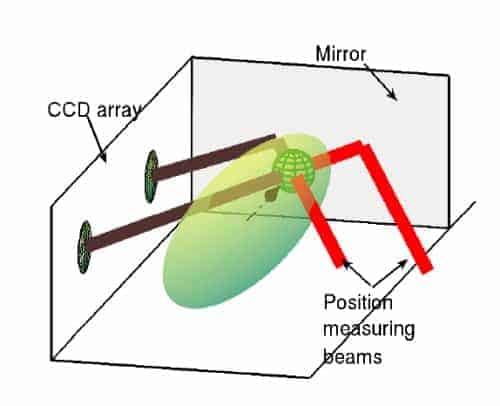The exploration of forces at the quantum level has long been a subject of intrigue within the realms of physics. The advent of Bose-Einstein Condensates (BECs) has revolutionized our understanding of quantum mechanics, particularly in the measurement of minuscule phenomena that evade conventional experimental approaches. Among the myriad of applications emerging from BEC research, the concept of utilizing BEC bubbles holds substantial promise for quantifying forces that are too diminutive to be measured through traditional means. This article delves into the principles underpinning BECs, the functional mechanisms of BEC bubbles, and the implications of measuring minuscule forces, all while encapsulating the various dimensions of content that readers can anticipate.
Bose-Einstein Condensates are a state of matter formed at temperatures approaching absolute zero, where a group of bosons occupies the same quantum state, instantiating macroscopic quantum phenomena. This behavior is epitomized by the indistinguishability of particles, leading to a collective state that challenges classical interpretations of particle dynamics. As the temperature decreases, particles condense into this collective ground state, revealing exotic properties such as superfluidity and coherence over vast distances. The understanding of BECs not only furthers theoretical physics but heralds applications in precision measurement and quantum computing.
Integral to the exploration of BECs is the realization that these condensates can be manipulated to create bubbles, which can serve as sensitive probes for measuring forces at unprecedented scales. The BEC bubble acts as a miniature observatory, capable of providing insights into the subtleties of the quantum realm. These bubbles are typically formed in a BEC by encasing a region of higher energy density, creating a delicate equilibrium between attractive and repulsive forces. The minute variations in the bubble’s properties in response to external influences allow researchers to ascertain the magnitude and nature of forces acting upon it.
Researchers have successfully demonstrated that BEC bubbles are adept at measuring forces stemming from various sources, including electromagnetic interactions and gravitational influences. One of the most striking advantages of utilizing BEC bubbles is their unmatched sensitivity. They can detect forces so subtle that traditional techniques, often reliant on larger-scale physical systems, fall short. The Bubbling phenomenon, where the BEC bubble oscillates in response to these forces, generates quantifiable changes in the bubble’s geometry and density distribution, offering data that can be meticulously analyzed.
The methodology for employing BEC bubbles encompasses a number of sophisticated techniques. Optical traps and laser cooling methods are pivotal in generating BECs and maintaining their stability as bubbles. Laser beams are used not only for cooling but also to manipulate the bubble’s shape and confinement, allowing researchers to explore the bubble’s response to external stimuli. The use of advanced imaging techniques, such as phase contrast microscopy, enables the precise observation of the dynamics of the bubble, further enhancing the measurement of minuscule forces.
As BEC bubble technology matures, the potential applications become increasingly pronounced. For instance, the detection of dark matter and other elusive particles could transform our understanding of the cosmos. Conventional methods for detecting such particles often rely on massive detectors that are either inefficient or fundamentally flawed for capturing minute interactions. In contrast, BEC bubbles may offer a novel pathway to unlock insights into dark matter by providing a modality for measuring the interaction of these particles with ordinary matter at low energy levels.
Moreover, BEC bubbles have far-reaching implications in the realm of fundamental physics. They are poised to unravel complex quantum phase transitions, shedding light on the nature of quantum entanglement and coherence. Such investigations could challenge existing paradigms and refine our grasp of quantum externalities. When quantum mechanics converges with gravitational effects, the BEC bubble may provide the necessary tools to explore the interplay between quantum and classical realities, potentially contributing to a broader theory of quantum gravity.
The essence of studying minuscule forces through BEC bubbles does not merely lie in quantification but extends to conceptual ramifications. Understanding the nature of these forces and their behaviors at the quantum level can redefine existing force models and improve predictive capabilities within both experimental and theoretical frameworks. Additionally, insights gained from BEC bubble experiments could bolster technologies such as quantum sensors and gravimeters, unlocking new dimensions in precision measurement.
Challenges remain, however. The generation and sustenance of BECs necessitate intricate experimental setups that require advanced technologies and very low temperatures. Researchers are continually faced with the challenge of effectively controlling the environmental conditions surrounding BEC bubbles to ensure accuracy and repeatability of measurements. Furthermore, the interpretation of data generated by BEC bubbles demands a high level of theoretical sophistication, given the non-trivial nature of quantum mechanics. Each advancement in the methodology bears the weight of scrutiny from the broader scientific community.
In conclusion, the potential of BEC bubbles as a measurement tool for assessing forces that elude traditional methods is immense. Advances in this field not only amplify our understanding of quantum physics but also orchestrate possibilities that could lead to groundbreaking technological innovations. The transition from theoretical contemplation to empirical validation will dictate the trajectory of research surrounding BEC bubbles, ultimately determining how effectively they can elucidate one of nature’s most profound mysteries — the dynamics of forces at the minuscule scale. As we stand on the cusp of new discoveries in this area, the nascent interplay of theory, experimentation, and technology beckons further inquiry and exploration.












